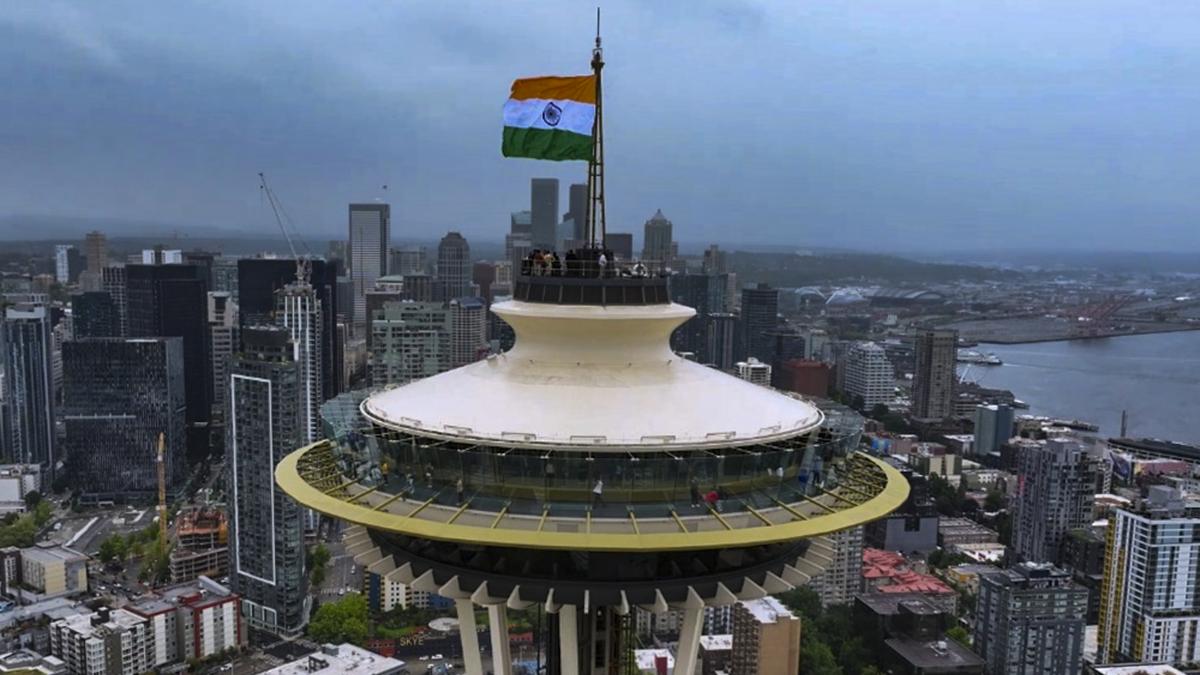
Indian Flag Flies Over Seattle’s Space Needle for the First Time in History

 :
| Updated On: 16-Aug-2025 @ 3:52 pm
:
| Updated On: 16-Aug-2025 @ 3:52 pmSHARE
On India’s 79th Independence Day, a historic moment unfolded in the United States when the Indian tricolour was hoisted atop Seattle’s iconic 605-feet-tall Space Needle for the very first time. This marked not only India’s national celebration but also the first time that a foreign nation’s flag was raised at the world-renowned American landmark. The event was attended by Consul General of India in Seattle, Prakash Gupta, along with Seattle Mayor Bruce Harrell and several prominent city leaders, making it a landmark occasion that highlighted the growing cultural and diplomatic ties between India and the Pacific Northwest.
Consul General Gupta expressed his pride on social media, posting a video of the flag flying high over the Seattle skyline. He described the moment as “no greater honour than this,” emphasizing its symbolic value for India, the diaspora, and bilateral relations. The Consulate General of India in Seattle also hailed the event as a “historic first,” underlining that it showcased the significant contributions of the Indian-American community in shaping Seattle’s emergence as a global technology hub in the U.S. Pacific Northwest.
To commemorate the milestone, the Consulate hosted a community reception at Kerry Park, with the Space Needle and the Indian flag in the background, creating a powerful visual symbol of friendship and diversity. The reception was attended by dignitaries including U.S. Congressman Adam Smith, Chief Justice of the Washington Supreme Court Debra Stephens, Seattle Port Commissioner Sam Cho, and AP Diaz, Superintendent of Seattle Parks and Recreation. A large number of Indian-American community members also gathered, eager to witness and celebrate this unprecedented occasion.
In his address, Congressman Adam Smith welcomed the hoisting of the tricolour as a tribute to diversity, unity, and the enduring relationship between India and the Pacific Northwest region of the United States. He noted that the event highlighted not only cultural pride but also the deepening ties that connect both societies.
The Space Needle, built in 1962 and long regarded as a symbol of Seattle’s futuristic vision, added weight to the occasion as it connected India’s independence to a landmark of American progress and innovation.
Adding to the celebration, King County, which encompasses 39 cities including Seattle, Spokane, Tacoma, and Bellevue, issued official proclamations declaring August 15 as “India Day.” This marked an important gesture of recognition and honour for the Indian community in the greater Seattle area.
Several other iconic landmarks across Seattle were also illuminated in the colours of the Indian tricolour, including Lumen Stadium, T-Mobile Stadium, the Westin, Seattle Great Wheel, and the Space Needle itself. Additionally, the Indian flag was hoisted at Tacoma Dome, Tacoma City Hall, and even at the headquarters of Tacoma’s Police and Fire Departments. These displays of solidarity reflected both the pride of the diaspora and the goodwill of local American institutions.
The celebrations concluded with a vibrant cultural extravaganza, featuring national anthems of both countries, traditional and contemporary Indian dance performances, and a poetic recital by acclaimed actor and artist Piyush Mishra. These performances highlighted India’s rich cultural heritage and brought the community together in a spirit of unity and pride.
Overall, the hoisting of the Indian tricolour at the Space Needle was more than a symbolic act—it was a reflection of India’s growing global presence, the strength of the Indian-American diaspora, and the enduring friendship between India and the United States.